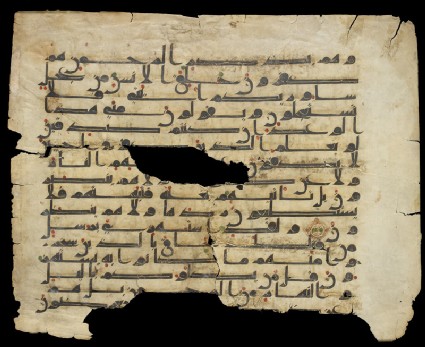Browse: 59 objects
- Reference URL
Actions
Page from a large Qur’an in kufic script
-
Description
Although severely damaged, this folio gives us a glimpse of the unique quality of the codex that once comprised it. The style in which it is written, characterized by a marked horizontal stretch in some letters (mashq), is one the most elegant renderings of kufic script, the angular style used for copying Qur'ans in the first centuries of Islam. The script on this page possesses a range of archaic features that have led scholars to associate the manuscript with an early date.
This idea is also reinforced by the likelihood that the vowels and diacritical marks, which look rather inconsistent and irregular when compared to the disciplined and balanced execution of the consonants, were added at a later date.
-
Details
- Associated place
- Date
- late 8th century - early 9th century AD
- Material and technique
- ink, colour, and gold on parchment
- Dimensions
-
mount 34 x 41.5 cm (height x width)
page 31 x 39.5 cm max. (height x width)
- Material index
- Technique index
- Object type index
- No. of items
- 1
- Credit line
- Bequeathed by Ralph Pinder-Wilson, 2009.
- Accession no.
- EA2009.18
Glossary
kufic
-
kufic
A term denoting various styles of angular Arabic script. Emerged in the early centuries of Islam, kufic soon became the preferred hand to copy holy texts.
Past Exhibition
see (1)Location
-
- currently in research collection
Objects are sometimes moved to a different location. Our object location data is usually updated on a monthly basis. Contact the Jameel Study Centre if you are planning to visit the museum to see a particular object on display, or would like to arrange an appointment to see an object in our reserve collections.
© 2013 University of Oxford - Ashmolean Museum


